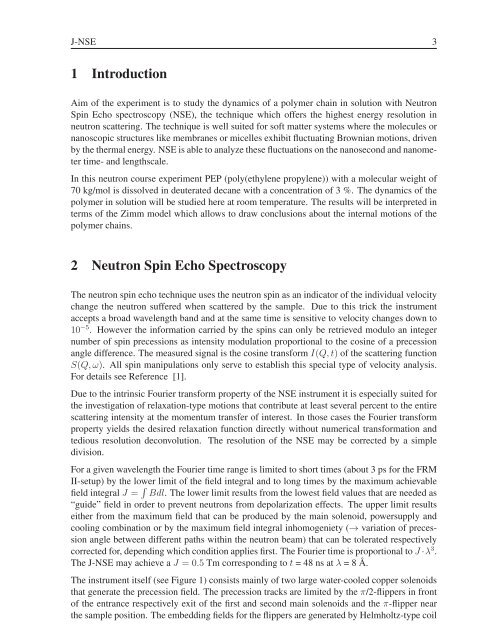Neutron Scattering - JUWEL - Forschungszentrum Jülich
Neutron Scattering - JUWEL - Forschungszentrum Jülich
Neutron Scattering - JUWEL - Forschungszentrum Jülich
Create successful ePaper yourself
Turn your PDF publications into a flip-book with our unique Google optimized e-Paper software.
J-NSE 3<br />
1 Introduction<br />
Aim of the experiment is to study the dynamics of a polymer chain in solution with <strong>Neutron</strong><br />
Spin Echo spectroscopy (NSE), the technique which offers the highest energy resolution in<br />
neutron scattering. The technique is well suited for soft matter systems where the molecules or<br />
nanoscopic structures like membranes or micelles exhibit fluctuating Brownian motions, driven<br />
by the thermal energy. NSE is able to analyze these fluctuations on the nanosecond and nanometer<br />
time- and lengthscale.<br />
In this neutron course experiment PEP (poly(ethylene propylene)) with a molecular weight of<br />
70 kg/mol is dissolved in deuterated decane with a concentration of 3 %. The dynamics of the<br />
polymer in solution will be studied here at room temperature. The results will be interpreted in<br />
terms of the Zimm model which allows to draw conclusions about the internal motions of the<br />
polymer chains.<br />
2 <strong>Neutron</strong> Spin Echo Spectroscopy<br />
The neutron spin echo technique uses the neutron spin as an indicator of the individual velocity<br />
change the neutron suffered when scattered by the sample. Due to this trick the instrument<br />
accepts a broad wavelength band and at the same time is sensitive to velocity changes down to<br />
10−5 . However the information carried by the spins can only be retrieved modulo an integer<br />
number of spin precessions as intensity modulation proportional to the cosine of a precession<br />
angle difference. The measured signal is the cosine transform I(Q, t) of the scattering function<br />
S(Q, ω). All spin manipulations only serve to establish this special type of velocity analysis.<br />
For details see Reference [1].<br />
Due to the intrinsic Fourier transform property of the NSE instrument it is especially suited for<br />
the investigation of relaxation-type motions that contribute at least several percent to the entire<br />
scattering intensity at the momentum transfer of interest. In those cases the Fourier transform<br />
property yields the desired relaxation function directly without numerical transformation and<br />
tedious resolution deconvolution. The resolution of the NSE may be corrected by a simple<br />
division.<br />
For a given wavelength the Fourier time range is limited to short times (about 3 ps for the FRM<br />
II-setup) by the lower limit of the field integral and to long times by the maximum achievable<br />
field integral J = � Bdl. The lower limit results from the lowest field values that are needed as<br />
“guide” field in order to prevent neutrons from depolarization effects. The upper limit results<br />
either from the maximum field that can be produced by the main solenoid, powersupply and<br />
cooling combination or by the maximum field integral inhomogeniety (→ variation of precession<br />
angle between different paths within the neutron beam) that can be tolerated respectively<br />
corrected for, depending which condition applies first. The Fourier time is proportional to J ·λ3 .<br />
The J-NSE may achieve a J =0.5Tm corresponding to t =48nsatλ =8 ˚A.<br />
The instrument itself (see Figure 1) consists mainly of two large water-cooled copper solenoids<br />
that generate the precession field. The precession tracks are limited by the π/2-flippers in front<br />
of the entrance respectively exit of the first and second main solenoids and the π-flipper near<br />
the sample position. The embedding fields for the flippers are generated by Helmholtz-type coil

















